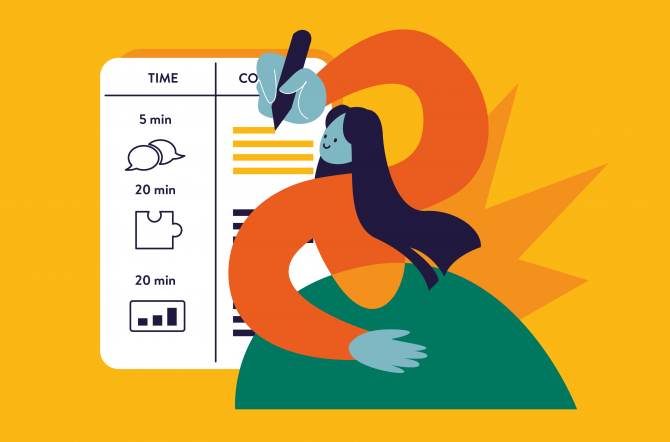Nearly everyone recognizes the value and benefits of effective training session plans, but creating a plan isn’t easy. So, what do you need to develop efficient training sessions? Below is a nine-step road map to help you make more effective training session plans.
- What is a Training Session Plan?
- Benefits of Using a Training Session Plan
- 9 Steps to Plan Training Sessions
- Step 1: Put your employees to the test before the training session
- Step 2: Keep in mind the principles of adult learning
- Step 3: Develop training objectives
- Step 4: Specify Useful Topics and Relevant Concepts
- Step 5: Form training materials
- Step 6: Prepare presentations
- Step 7: Make training sessions fun to learn
- Step 8: Include an evaluation
- Step 9: Manage your time
- Conclusion
What is a Training Session Plan?
Training sessions are programs designed to provide staff with educational values. It can be corporate training or team skill training. These sessions aim to increase knowledge and professional skills, boost morale, and so on.
A training session plan describes the materials and activities to guide a team toward a particular learning goal.
The training session plan specifies the teaching subject matter, each section length, the instruction method for each topic, and the measures you’ll employ to ensure that executives have learned what you expect them to know.
Benefits of Using a Training Session Plan
A good training session plan will benefit both you and your trainers. You visualize each step of the lecture as you plan. It ensures that you have considered everything you need to say and that you convey information in a logical order. You’ll also be able to prepare for points people may find difficult to grasp.
Following your session, you can use your plan to determine what went well – and what did not – so that you can improve it for future lessons.

9 Steps to Plan Training Sessions
Step 1: Put your employees to the test before the training session
Conduct a test to gather information to structure your training course. You will realize what the staff needs to learn and be able to plan your session. As a result, it aids in establishing the company’s requirements by upskilling the team and achieving business objectives.
Step 2: Keep in mind the principles of adult learning
Participants in a staff training program often have more experience than young students in a school setting. Therefore, you should consider the following characteristics of adult learners:
- Experience is a vital part of any learning.
- Learning should involve real-world implementations.
- Adult learners are typically eager to learn, especially if the subject matters interest them.
Step 3: Develop training objectives
The learning objectives form the foundation of the training session. These will highlight the team’s knowledge, professional skills, and so on as a result of attending the training session.
You should obtain these learning objectives from the above test assessments. Below are some questions you can consider:
- What are the most critical aspects or skills that learners must grasp by the end of the course?
- The importance of these concepts and abilities?
- How will you know if they have correctly understood the concept?

Recommend reading:
- How To Write Training Objectives For eLearning Effectively
- 11 Simple Steps to Create an Online Training Course Like a Pro
Step 4: Specify Useful Topics and Relevant Concepts
Your training will concentrate on key ideas or skills, but you must explain the concepts to meet your learning objectives.
Select your key topics and relevant concepts, then group them to showcase how they are related.
Step 5: Form training materials
Training materials are an essential step in conducting an effective training session plan. There are 2 types of training material categories:
- Training materials for the coaches
- Training materials for participants
The material should support the coach’s ideas, stimulate him, and keep him organized. Attendees should create a list of experiences to help them understand and develop new skills. As an organizer and trainer, highlight the session’s relevant goals.
Recommend reading:
Step 6: Prepare presentations
The presentation should be simple for your learners to understand the training goals. It will serve as a guide for the organizer and the attendees throughout the session.
Each slide should contain one idea. There should be no more than six bullet points, with each bullet containing no more than six words. To enhance the learning experience and keep your learners engaged, consider incorporating voice narration into your presentations.
Adding an eLearning voice-over service can provide clear and professional audio explanations, making the content more accessible and engaging for your audience.
To find the best providers of these services, check out our guide on eLearning Voice Over Services: Top 8 Best-Pick Companies
Step 7: Make training sessions fun to learn

Hundreds of people may attend the session, many of whom may not know each other. Because interaction with teammates is essential for teamwork, games come into play.
Try to prepare activities to help generate a new common trait, bonding, and a more relaxed environment.
Consider these activities:
- Demonstration: This is suitable when you need to demonstrate the steps of a procedure or task. Learners can try out the step on their own, or you can showcase it in front of the class.
- Discussions and debates: They enable trainees to ask questions about the concepts they have just learned. Consider distributing a list of queries to arouse a discussion.
- Role play: Learners try out a new skill in a modeled environment and learn from other learners’ feedback.
- Small group teaching: It helps learners clarify their understanding of new information. They can explain and answer questions to one another in their own words.
Recommend reading:
Step 8: Include an evaluation
Evaluation of training is essential for developing your learners’ skills and experience. It also allows you to determine whether or not your learners meet the training goals.
Feedback can be intimidating, but it is essential for your professional development as a trainer.
Step 9: Manage your time
Being an organizer implies being a manager at all times. Make a schedule and stick to it to ensure you have enough time to cover every aspect of the training session. Think about some concepts or skills that require more time than usual. You must remember those ideas and plan your schedule accordingly.

Conclusion
Does training play a vital role in the workplace? Absolutely. However, the effectiveness of a training session plan depends on how it is designed, developed, and implemented. If you follow the nine steps outlined above, your training programs will be far more effective, resulting in increased training ROI, happier employees, and key business objectives.
Read more:




